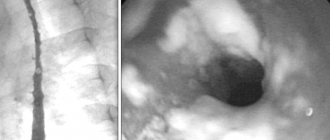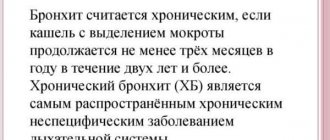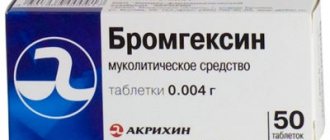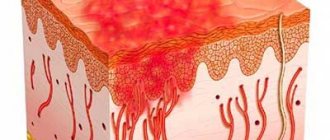Pharmacodynamics and pharmacokinetics
The pharmacological effect of the drug is based on blocking the biosynthesis of microbial cell walls. The antibiotic Cefazolin is active against gram-positive (Streptococcus spp., Staphylococcus spp.) and gram-negative bacteria (Klebsiella spp., Escherichia coli, Treponema spp., Haemophilus influenzae, Proteus mirabilis, Neisseria gonorrhoeae, Enterobacter aerogenes).
The drug is poorly absorbed from the gastrointestinal tract when used internally, therefore it is used for intravenous and intramuscular injections . After intramuscular injections at a dosage of 0.5 g, the maximum concentration is observed after 1-2 hours. Plasma protein binding is approximately 85%.
The active substance of the drug penetrates bone tissue, as well as pleural , ascitic and synovial fluid , but is not detected in the nervous system.
The half-life of the drug is approximately 1.8 hours. The drug is excreted unchanged in the urine.
With intramuscular injections, about 80% of the dose is eliminated after 24 hours. In case of renal dysfunction, the plasma half-life increases.
Pharmacological properties of the drug Cefazolin
Pharmacodynamics. Cefazolin has a wide spectrum of antimicrobial (bactericidal) action. Active against gram-positive microorganisms ( Staphylococcus spp ., producing and not producing penicillinase, most strains, including pneumococci, Corinebacterium diphtheriae ); gram-negative microorganisms ( Escherichia coli, Salmonella spp., Shigella spp., Proteus mirabilis, Klebsiella spp., Haemophylus influenzae, Enterobacter aerogenes, Neisseria gonorrhoeae ). Indole-positive strains of Proteus ( P. morgani, P. vulgaris, P. rettgeri ), Pseudomonas aeruginosa are resistant to the antibiotic; does not affect rickettsia, viruses, fungi, protozoa. Like penicillins, it inhibits the synthesis of bacterial cell walls. Pharmacokinetics. When administered intramuscularly, the drug is rapidly absorbed, reaches a maximum concentration in the blood after 1 hour and is retained in an effective concentration in the blood plasma for 8–12 hours. It is excreted mainly (approximately 90%) by the kidneys unchanged. Penetrates through the placental barrier into amniotic fluid and umbilical cord blood. Found in very low concentrations in breast milk. The drug penetrates well through the inflamed synovium into the joint cavity. With intravenous administration, a higher concentration is formed in the blood, but the drug is released faster (half-life is about 2 hours).
Indications for use of Cefazolin
Indications for use of Cefazolin are as follows:
- infections of the biliary and urinary tract ;
- infectious diseases of the respiratory tract;
- inflammation in the abdominal cavity and pelvic organs;
- blood poisoning;
- peritonitis and sepsis ;
- skin infections after burns, surgeries and wounds;
- inflammation of the lining of the heart;
- and joint infections ;
- venereal diseases;
- infectious skin diseases;
- mastitis.
For what purpose the drug will be effective in each individual case, it is necessary to consult a specialist. Only a doctor knows the exact indications for the use of Cefazolin. For example, he may recommend a drug for sore throat , skin infections , or blood poisoning .
The medicine is also used in veterinary practice for cats. Injections help with blood poisoning , peritonitis , meningitis , as well as many infectious diseases .
For what pathologies is Cefazolin indicated?
Antibiotic injections are prescribed:
- for infectious lesions of the urinary system, liver, gall bladder;
- infectious bronchitis and pneumonia;
- for inflammatory diseases of the abdominal cavity and pelvic organs;
- with peritonitis and sepsis;
- for infectious complications after surgery;
- with mastitis;
- skin infections;
- sexually transmitted diseases.
The drug can be used from the age of 1 month.
Side effects
Using the medication may cause the following side effects:
- organs of the digestive system: diarrhea , nausea, vomiting;
- chemotherapeutic effect: candidiasis , pseudomembranous colitis ;
- allergies : urticaria , eosinophilia , itching , fever ;
- local reactions: pain at the site of intramuscular injection.
In rare cases, there is a transient increase in the activity of liver transaminases , anaphylactic shock , arthralgia , angioedema , leukopenia (reversible), thrombocytopenia , neutropenia , renal dysfunction .
Side effects of the drug
Cefazolin injections cause a local painful reaction: a strong burning sensation at the injection sites that lasts for several minutes. This effect does not require discontinuation of the drug. Other side effects:
- dyspepsia: nausea, stomach cramps, loss of appetite;
- stool disorder;
- fungal infections of the skin and mucous membranes;
- changes in blood count: thrombocytopenia, leukopenia, increased liver transaminases;
- aching pain in the joints.
If you are allergic to the drug, in rare cases, Quincke's edema develops, skin itching, fever, and urticaria are possible. In case of overdose, cardiotoxic shock, arrhythmia, and vomiting develop.
Instructions for the use of Cefazolin injections (Method and dosage)
When Cefazolin injections are prescribed, the instructions for use indicate that the dosage and duration of the course may vary depending on the disease and the individual sensitivity of the patients. Daily dosage for adults is from 1 to 6 g. Injections are given 2-3 times daily. Therapy is designed for a maximum of 7-10 days.
The drug is administered intramuscularly or intravenously . Depending on this, they decide how to dilute Cefazolin. When intramuscularly , the medicine is diluted with water or sodium chloride solution. For intravenous injections, sodium chloride is mainly used. In this case, the drug is administered slowly. Administration time is approximately 5 minutes.
If a patient is placed on a drip , the antibiotic is usually diluted with glucose, and sodium chloride is used only in rare cases.
For the treatment of inflammation of the lining of the heart, joints, purulent pleurisy , bones, abdominal cavity, blood poisoning , 1 g of the drug is administered 3 times every day. In case of kidney dysfunction, the dosage should be halved.
The drug cannot be combined in the same syringe with other antibiotics .
In addition to water and sodium chloride, the medicine is also sometimes diluted with Novocaine . It is topical anesthetic This drug has been used in medical practice for quite a long time, so there is an established scheme for diluting Cefazolin with Novocaine . The latter is taken at a concentration of 0.25%. Before diluting this drug with Novocaine It is enough just to add 2-3 ml to the antibiotic and then shake well. The result is a ready-made solution for single use.
For some indications, the drug is also used in veterinary practice instead of using tablets. In this case, it is diluted in Lidocaine or Novocaine . The dosage for cats depends on the weight of the pet, it is calculated so that 10 mg is per 1 kg. Therapy lasts 5-10 days. Before using the medicine, you should consult your veterinarian.
Cefazolin Akos is often used as an analogue of the drug for humans . It is also administered through intramuscular and intravenous injections (stream and drip). Instructions for use of Cefazolin Akos reports that the average daily dosage for adults is 1 g. They need to be administered 2 times a day. The maximum dose per day should not exceed 6 g. If necessary, the frequency of use can be increased to 3-4 times a day. The average duration of therapy is 7-10 days.
The average daily dosage for children is 25-30 mg/kg, and in case of severe infections - 100 mg/kg.
In case of renal dysfunction, doses are adjusted.
For intramuscular injections, an antibiotic in a dose of 500 mg is mixed with 2 ml of water, 1 g is diluted in 2.5 ml of water. For intravenous administration, the medicine is mixed with 5 ml of water and administered for 3-5 minutes.
Cefazolin solution for injection 1 g in a bottle
Before starting each new course of treatment with cefazolin, it should be established whether the patient has had hypersensitivity reactions to cefazolin, cephalosporins, penicillins, other β-lactam antibiotics, or other drugs in the past.
There is a possibility of cross-allergic reactions between penicillins and cephalosporins. Severe hypersensitivity reactions (including anaphylaxis) have been reported.
Antibiotics should be prescribed cautiously to patients with a history of any form of allergic reaction, especially to drugs.
As with other cephalosporins, the possibility of severe acute allergic reactions, including anaphylactic shock, cannot be excluded, even if a detailed history does not provide relevant data. If such reactions develop, it is necessary to administer adrenaline (epinephrine), glucocorticoids and take other emergency measures.
Cephalosporins can be absorbed onto the surface of red blood cell membranes and interact with antibodies directed against the drug. This may cause a false-positive Coombs test result (for example, in children whose mothers were treated with cefazolin) and very rarely, hemolytic anemia. This reaction may cause cross-reactivity with penicillins.
Treatment with antibacterial drugs, especially for severe diseases in the elderly, as well as in weakened patients and children, can lead to antibiotic-associated diarrhea, colitis, including pseudomembranous colitis. Therefore, if diarrhea occurs during or after treatment with cefazolin, it is necessary to exclude these diagnoses, including pseudomembranous colitis. The use of cefazolin should be discontinued in case of severe and/or bloody diarrhea and appropriate therapy should be instituted. In the absence of necessary treatment, toxic megacolon, peritonitis, and shock may develop.
It should be prescribed with caution to patients with a history of diseases of the digestive tract, especially colitis. Long-term use of antibacterial drugs can lead to excessive growth of insensitive microorganisms, fungi and the development of superinfection, which requires appropriate measures.
Caution should be used in patients with impaired renal function, as well as in patients with epilepsy or disorders of the central nervous system. Treatment of patients with impaired renal function is carried out in a hospital; the daily dose should be reduced to avoid toxic effects. No dose adjustment is required for geriatric patients with normal renal function.
Intrathecal administration of the drug is not recommended. There have been reports of severe toxic reactions from the central nervous system, including seizures, when using this particular route of administration of the drug, as well as when doses of the drug were exceeded due to renal dysfunction.
During long-term treatment with the drug, it is recommended to regularly monitor the blood count, indicators of the functional state of the liver and kidneys.
In patients with impaired synthesis or deficiency of vitamin K (for example, in the presence of chronic liver disease, kidney disease, in elderly patients, with long-term antibiotic therapy), with long-term anticoagulant therapy prior to the administration of cefazolin, prothrombin time should be monitored.
During treatment, false-positive results of glucosuric tests performed by non-enzymatic methods may be observed. The drug does not affect the results of glucosuric tests performed by enzymatic methods.
Only clear, freshly prepared solutions of the drug are suitable for use.
Overdose
Administration of the drug in high doses may cause dizziness , headache and paresthesia . People with chronic kidney failure neurotoxic effects . Convulsions, tachycardia and vomiting are noted.
In case of toxic reactions and signs of overdose, the elimination of the drug can be accelerated through the use of hemodialysis .
Interaction
When the drug is combined with aminoglycosides , Rifampicin , Vancomycin , a synergistic antimicrobial effect is observed . Aminoglycosides increase the likelihood of kidney damage. The drug is incompatible with them.
It is undesirable to combine the medication with anticoagulants and diuretics .
Interaction with agents that inhibit tubular secretion increases the level of the active substance of the drug in the blood, increases the likelihood of toxic reactions and slows down the elimination time.
Analogues of Cefazolin
Level 4 ATC code matches:
Cephalexin
The following analogues of Cefazolin are known:
- Cefazex;
- Cefazolin-Astrapharm;
- Cefazolin Acos;
- Reflin;
- Cesolin;
- Cefazolin-Pharmex;
- Cefamezine.
All of these medications are sold in powder form. Common analogues are not available in tablets.
Cefazolin price, where to buy
The price of Cefazolin injections can vary greatly depending on the seller. Ampoules of medicine (1 g) can cost from 20 rubles. The maximum price of Cefazolin for 1 bottle of 1 g reaches 120 rubles.
- Online pharmacies in RussiaRussia
- Online pharmacies in UkraineUkraine
- Online pharmacies in KazakhstanKazakhstan
ZdravCity
- Cefazolin powder for injection solution for intravenous and intramuscular administration 1g LEKKOZAO Pharmaceutical company LEKKO
RUR 31.order
Pharmacy Dialogue
- Cefazolin (vial 1g i.v. i.m. individual pack) Biosynthesis OJSC
42 RUR order
- Cefazolin (vial 1g intravenous i.m. individual pack) Kraspharma OJSC
42 RUR order
- Cefazolin-Akos (vial 1g i.v. i.m. individual pack) Synthesis OJSC
32 RUR order
- Cefazolin (vial 1g IM, IV) Lecco JSC
35 rub. order
- Cefazolin (vial 1g i.v. i.m. individual pack) BZMP
51 RUR order
show more
Pharmacy24
- Cefazolin-Darnitsa 1g N5 PrAT Pharmaceutical company Darnitsa, Ukraine
73 UAH order - Cefazolin-Darnitsa 0.5 g No. 5 powder PrAT” Pharmaceutical company “Darnitsa”, Ukraine
55 UAH order
- Cefazolin 0.5 g N10 powder PAT "Kievmedpreparat", Ukraine
94 UAH order
- Cefazolin 1 g N5 solution for injection AT Lekhim-Kharkiv, Ukraine
55 UAH order
- Cefazolin 1 g No. 1 injection solution AT "Lekhim-Kharkiv", Ukraine
12 UAH order
PaniPharmacy
- Cefazolin bottle Cefazolin powder for injection 0.5g bottles No. 5 Ukraine, Darnitsa ChAO
60 UAH.order
- Cefazolin por. d/in 1g No. 5 Ukraine, Lekhim-Kharkov
71 UAH order
- Cefazolin bottle Cefazolin pores. d/r-ra d/in. 1g fl. No. 10 Ukraine, Kievmedpreparat OJSC
124 UAH order
- Cefazolin bottle Cefazolin pores. d/r-ra d/in. 0.5g fl. No. 10 Ukraine, Kievmedpreparat OJSC
93 UAH order
show more
Special instructions for the use of Cefazolin
In patients with reduced renal function, it is necessary to select the dose and intervals between administrations of cefazolin depending on the degree of functional failure. If renal function is impaired, constant monitoring of the level of cefazolin in the blood serum will ensure the safety of the drug. If signs of allergic reactions appear, administration of the drug should be discontinued; it is necessary to prescribe appropriate symptomatic treatment. It is possible to develop cross-allergic reactions with other cephalosporin antibiotics, as well as in some cases with penicillin antibiotics. Studies have not revealed any adverse effects of cefazolin on the fetus. Cefazolin does not affect the ability to drive vehicles or operate potentially dangerous machinery.








